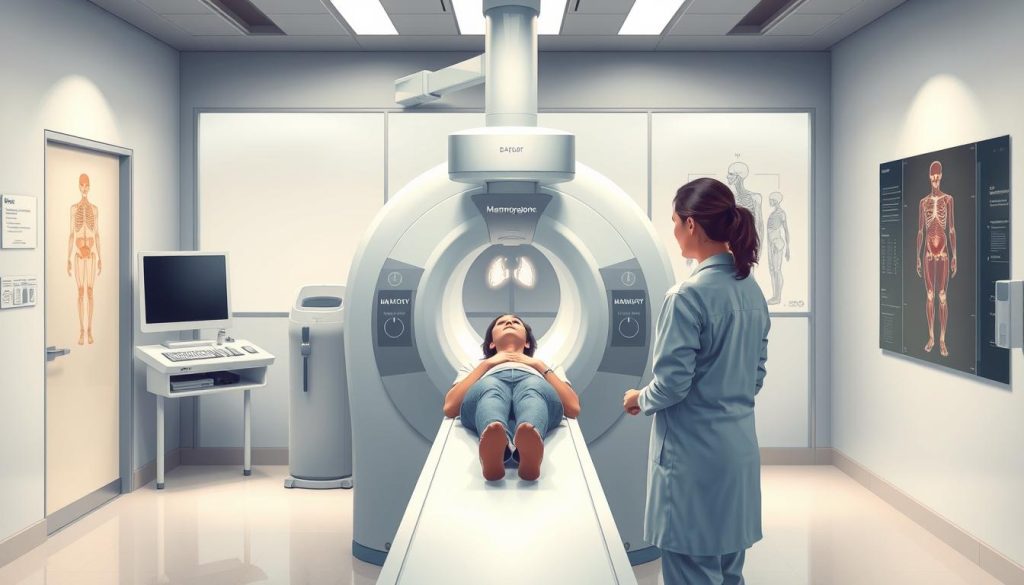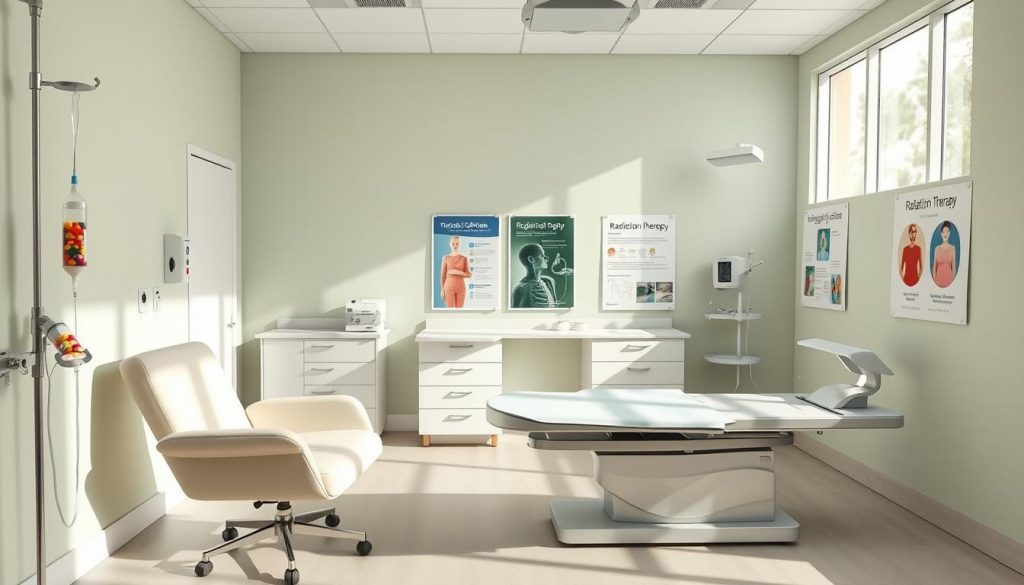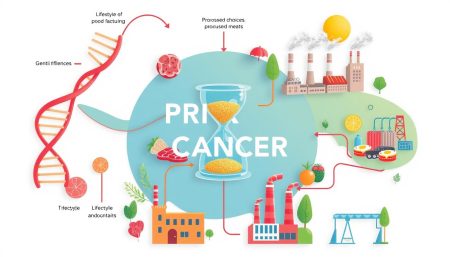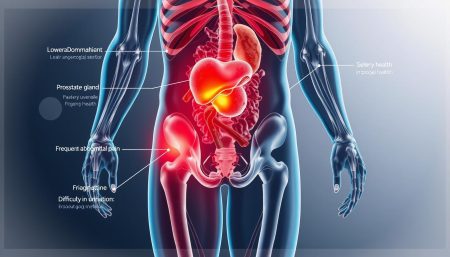Breast cancer is a serious health issue that affects millions of women globally. Spotting the signs early can greatly improve treatment results. Early detection often means better treatments and higher survival chances.
Knowing the warning signs is key to keeping your breasts healthy. This article will look at common breast cancer signs and why self-examination is important. By recognizing these early signs, you can take action and get medical help when needed.
Not all breast changes mean cancer, but it’s vital to watch for unusual symptoms. It’s important to see a healthcare professional if you notice anything odd. Let’s explore the main warning signs and how to spot them.
Understanding Breast Cancer: A Comprehensive Overview
Breast cancer is a serious disease that changes lives worldwide. This overview explains its nature, its global impact, and why early detection is key to better outcomes.
What Defines Breast Cancer
Breast cancer happens when cells in the breast grow out of control. These cells can form tumors and spread to other parts of the body. It mainly hits women, but men can get it too.
Impact on Global Health
Breast cancer is the top cancer for women worldwide. It affects millions every year, causing big physical, emotional, and financial problems. Here’s a look at its numbers:
| Region | New Cases (2020) | Deaths (2020) |
|---|---|---|
| North America | 253,465 | 44,130 |
| Europe | 531,086 | 141,765 |
| Asia | 1,068,598 | 458,209 |
Importance of Early Detection
Early detection is vital in fighting breast cancer. If caught early, treatments work better and survival chances go up. Regular check-ups and self-exams help find signs early, before the cancer spreads.
Common Signs of Breast Cancer
Spotting breast cancer early can save lives. A lump is often the first sign, but there are others too. Knowing these signs helps you take care of your breast health.
- A new lump or mass in the breast or underarm area
- Changes in breast size, shape, or appearance
- Skin dimpling or puckering on the breast
- Nipple changes, including inversion or discharge
- Breast or nipple pain
- Redness, scaliness, or thickening of the nipple or breast skin
A breast lump doesn’t always mean cancer. Many are harmless, but any new lump should be checked. Self-exams and doctor visits can catch these signs early.
| Sign | Description | Action |
|---|---|---|
| Breast lump | Hard, painless mass with irregular edges | Consult doctor immediately |
| Skin changes | Dimpling, puckering, or orange-peel texture | Schedule a check-up |
| Nipple discharge | Clear or bloody fluid | Seek medical evaluation |
These signs can differ for everyone. If you see any odd changes in your breasts, call your doctor. Finding cancer early can greatly improve treatment chances.
Visual Changes in Breast Appearance
It’s important to notice changes in your breasts early. These changes can be small but mean a lot. Let’s look at some key signs to watch for during self-exams.
Skin Dimpling and Puckering
Dimpling or puckering is a clear sign. It looks like the surface of an orange peel. If you see this, see your doctor right away.
Breast Color and Texture Changes
Watch for color or texture changes in your skin. Redness, scaliness, or thickening are signs. These changes might be in part or all of your breast.
Asymmetry and Size Differences
It’s normal for breasts to differ slightly. But sudden size or shape changes are a worry. Look out for new asymmetry or swelling.
These changes don’t always mean cancer. But they’re worth checking. Knowing your breasts can help you spot issues early. If you see any unusual signs, get medical help.
Identifying Breast Lumps and Masses
Breast lumps are a common worry for many women. Most are not cancerous, but it’s important to know how to spot them. Early signs of breast cancer symptoms can lead to better treatment.
A breast lump feels like a small, firm knot under the skin. It can be painful or not hurt at all. It can move or stay in one place. The feel can range from soft to hard.
Not every lump means cancer. Many are benign, like cysts or fibroadenomas. But any new or odd breast lump needs a doctor’s check.
Characteristics of breast lumps include:
- Size: Can range from tiny to several centimeters
- Shape: Round, oval, or irregular
- Texture: Smooth or rough
- Mobility: Fixed or movable within the breast tissue
Where the lump is located is also important. Lumps often show up in the upper outer part of the breast. But they can appear anywhere, even near the armpit.
Doing regular self-exams helps you get to know your breasts. This makes it easier to notice any changes. If you find a new lump or a change in an old one, don’t worry. Just make an appointment with your doctor for a detailed check.
| Characteristic | Benign Lump | Potentially Cancerous Lump |
|---|---|---|
| Texture | Smooth, rubbery | Hard, irregular |
| Mobility | Moves easily | Often fixed in place |
| Pain | Often tender | Usually painless |
| Growth | Slow or no growth | May grow rapidly |
Early detection is key. Knowing how to spot breast lumps helps you take care of your breast health. Regular check-ups and quick action on changes are important steps in fighting breast cancer risk.
Nipple-Related Warning Signs
Nipple changes can be important breast cancer symptoms. Being aware of these signs helps with early detection. Let’s explore key nipple-related warning signs to watch for.
Nipple Discharge Types
Nipple discharge can vary in color and consistency. Clear or bloody discharge may signal a problem. Greenish or milky discharge is often less concerning. If you notice any unusual nipple discharge, see your doctor.
| Discharge Color | Potential Indication | Action Required |
|---|---|---|
| Clear or Bloody | Possible tumor | Immediate medical attention |
| Greenish | Infection or cyst | Medical evaluation |
| Milky | Hormonal changes | Monitor and consult if persistent |
Changes in Nipple Direction
If your nipple starts to turn inward or pull to one side, it could be a sign of breast cancer. This change happens when a tumor pulls on the tissue behind the nipple. Report any nipple direction changes to your doctor.
Nipple Pain and Sensitivity
Sudden nipple pain or increased sensitivity might indicate breast cancer. While occasional discomfort is normal, persistent or severe pain needs medical attention. Keep track of when and how often you experience nipple pain.
Understanding Breast Pain Patterns
Breast pain is common among women. It’s key to know the different types to tell normal pain from possible cancer signs. Most breast pain isn’t cancer, but noticing odd patterns can help catch cancer early.
Cyclical breast pain is linked to hormonal changes during your period. It usually affects both breasts and changes in intensity each month. Non-cyclical pain, though, might be more serious. It can happen in one spot and last longer than usual.
Sharp, lasting pain in one area could be a cancer sign. If you have ongoing discomfort, and it’s with lumps or skin changes, see a doctor. They can figure out what’s wrong and help you.
Doing breast self-exams is important to find unusual changes. Get to know how your breasts feel normally. This way, you can easily notice any new or odd feelings. Being alert and knowing about breast pain types helps you take care of your breast health.
Less Common Warning Signals to Watch For
Many people know the usual signs of breast cancer. But, some less obvious signs can be missed. It’s important to notice these subtle changes early. Let’s look at some less common warning signals that need attention.
Underarm Swelling
Swelling in the armpit might not seem like a breast cancer sign. But, it can be. If breast cancer spreads, lymph nodes in this area can get bigger. If you see ongoing swelling or a lump in your underarm, see a doctor.
Collar Bone Area Changes
Changes near your collar bone can also hint at breast cancer. Look for swelling, lumps, or skin changes. These signs might show up if cancer cells reach lymph nodes above the collar bone.
Upper Body Skin Alterations
Skin changes on your upper body, not just the breast, can warn you. Watch for redness, thickening, or dimpling on your chest, upper arm, or back. These signs might show up when cancer spreads.
| Warning Signal | What to Look For | Action |
|---|---|---|
| Underarm Swelling | Persistent lump or swelling | Consult doctor |
| Collar Bone Changes | Unusual swelling or lumps | Schedule check-up |
| Skin Alterations | Redness, thickening, dimpling | Seek medical advice |
These signs don’t always mean breast cancer. But, they’re worth checking out. Keep an eye on your body and talk to your doctor if you notice anything odd. Catching cancer early can greatly improve treatment outcomes.
Risk Factors and Prevention Strategies
Understanding risk factors and prevention strategies is key in fighting breast cancer. Some risks we can’t control, but others we can manage through lifestyle choices.
Genetic factors are a big part of breast cancer risk. Women with a family history or certain gene mutations, like BRCA1 and BRCA2, are at higher risk. Age also plays a role, with risk increasing as women get older.
Lifestyle choices can affect breast cancer risk. Keeping a healthy weight, exercising regularly, and drinking less alcohol are important. Eating a diet full of fruits, vegetables, and whole grains can also help.
- Avoid smoking
- Limit hormone replacement therapy
- Breastfeed, if possible
- Stay physically active
Regular screenings are key for early detection. Mammograms, clinical breast exams, and self-exams can spot issues early. Women should talk to their healthcare providers about their risk factors to find the best screening schedule.
Even with these strategies, breast cancer can happen. But staying informed and proactive about breast health is the best defense.
Breast Self-Examination Techniques
Regular breast self-exams are key to catching breast cancer early. By knowing what your breasts usually look and feel like, you can spot changes fast. Here’s how to do a good breast self-exam.
Step-by-Step Examination Guide
A good breast self-exam includes looking and feeling:
- Stand in front of a mirror with your arms at your sides
- Raise your arms and look for changes in breast shape or skin texture
- Feel your breasts while lying down, using circular motions with your fingertips
- Check your entire breast area, from collarbone to ribcage
- Gently squeeze your nipples to check for discharge
Best Time for Self-Examination
Do your breast self-exam at the same time every month. For women who menstruate, the best time is a few days after your period. This is when your breasts are least swollen or tender. Women who are postmenopausal can pick any day of the month.
Documentation Methods
Keep a journal for your breast self-exams. Write down the date, any changes you see, and any areas of concern. This journal can help when you talk to your healthcare provider. It supports early detection efforts.
Professional Screening and Detection Methods
Early detection of breast cancer is key to saving lives. Healthcare professionals use various methods to find cancer early. Let’s look at the most effective ways to do this.
Mammogram Guidelines
Mammograms are the top choice for finding breast cancer. Women between 40 and 44 can start getting annual mammograms. From 45 to 54, yearly checks are advised. After 55, screenings can be every two years or yearly, depending on your risk.

Ultrasound Benefits
Ultrasounds help when mammograms aren’t clear, like with dense breasts. This method uses sound waves to show detailed images. It’s great for telling solid masses from fluid-filled cysts.
MRI Recommendations
Breast MRIs are not routine but are helpful for some. They’re good for those at high risk, like those with a family history of breast cancer. High-risk women might get annual MRI scans along with mammograms.
| Screening Method | Recommended Age | Frequency |
|---|---|---|
| Mammogram | 40+ | Annual or Biennial |
| Ultrasound | Any age | As needed |
| MRI | High-risk individuals | Annual |
Keep in mind, these are general guidelines. Talk to your doctor to find the best screening plan for you. Regular checks are vital for catching breast cancer early and improving treatment outcomes.
When to Consult Healthcare Providers
Spotting breast cancer symptoms early is key to saving lives. Regular self-exams are important, but knowing when to see a doctor is just as vital. If you notice any unusual changes in your breasts, don’t hesitate to see a doctor.
- A new lump or thickening in your breast or underarm
- Changes in breast size, shape, or appearance
- Skin dimpling or puckering on the breast
- Nipple changes, including inversion or discharge
- Persistent breast pain or discomfort
Early detection of breast cancer symptoms can lead to better treatment options. If something feels off, don’t hesitate to reach out to your doctor. They can do thorough exams and suggest the right screening methods.
Most breast changes aren’t cancerous, but it’s always safer to be cautious. Your healthcare provider is your best ally for addressing concerns and keeping your breast health in check. Trust your instincts and prioritize your well-being by getting medical help when needed.
Treatment Options and Early Intervention
Breast cancer treatment has made big strides, giving patients many choices. Starting treatment early is key to better results and longer life. Let’s look at the main ways to treat breast cancer.
Surgery Considerations
Surgery is a big part of treating breast cancer. You might have a lumpectomy, which keeps the breast but removes the tumor. Or, you might have a mastectomy, which takes out the whole breast. The choice depends on the tumor’s size, where it is, and how far it has spread.
Radiation Therapy Overview
Radiation therapy uses beams to kill cancer cells. It’s often used after surgery to get rid of any cancer left behind. Treatment lasts a few weeks, with sessions five days a week.
Chemotherapy Protocols
Chemotherapy uses drugs to kill cancer cells all over the body. It can be used before surgery to make tumors smaller or after to get rid of any left behind. How long and how intense chemotherapy is depends on the cancer type and how far it has spread.
Targeted Therapies
Targeted therapies attack specific parts of cancer cells. For example, hormone therapy is for cancers that grow because of hormones. HER2-targeted drugs are for cancers with too much HER2. These treatments often have fewer side effects than traditional chemotherapy.

| Treatment Type | Purpose | Duration |
|---|---|---|
| Surgery | Remove tumor | One-time procedure |
| Radiation | Destroy remaining cancer cells | Several weeks |
| Chemotherapy | Kill cancer cells throughout body | 3-6 months |
| Targeted Therapy | Attack specific cancer cell features | Varies (months to years) |
Starting treatment early is very important for breast cancer. Regular check-ups and acting fast if you notice any changes in your breast are key. This way, cancer can be caught early when it’s easier to treat.
Living with Breast Cancer: Support and Resources
A breast cancer diagnosis can feel overwhelming, but you’re not alone. Breast cancer support networks offer emotional guidance and practical help. They connect you with others facing similar challenges, providing a safe space to share and learn.
Financial worries often come up during treatment. Many organizations offer financial aid to help with medical costs, transportation, and daily needs. These resources can help ease your financial stress, letting you focus on your health and recovery.
Learning about your condition is empowering. There are many breast cancer resources that provide the latest information on treatments, side effects, and lifestyle changes. From webinars to printed materials, these tools help you make informed decisions about your care. Remember, knowledge is a powerful ally in your journey with breast cancer.
Survivorship programs offer guidance for life after treatment. They address long-term effects, emotional well-being, and strategies for a healthy lifestyle. By using these breast cancer support services, you can find strength, hope, and a path forward in your cancer journey.
FAQ
Q: What are the most common signs of breast cancer?
A: Common signs include a lump in the breast, changes in size or shape, and skin changes like dimpling. Nipple discharge, changes in nipple direction, and persistent pain are also signs. Remember, these symptoms can also have non-cancerous causes, so always see a doctor.
Q: How often should I perform a breast self-exam?
A: Do a breast self-exam once a month. Do it a few days after your period ends when your breasts are less swollen. For those without periods, pick a consistent day each month. Self-exams help you know what’s normal for your breasts.
Q: At what age should I start getting mammograms?
A: Women should start mammograms at 45, says the American Cancer Society. Those 40-44 can start yearly. Women 55 and older can go every two years or yearly. Talk to your doctor about your risk for the best schedule.
Q: Can breast cancer occur in men?
A: Yes, breast cancer is rare in men but can happen. About 1% of cases in the U.S. are in men. If you notice changes in your chest, like lumps or nipple discharge, tell your doctor right away.
Q: What are the risk factors for breast cancer?
A: Risk factors include age, genetic factors like BRCA1 and BRCA2, and family history. Personal history of breast cancer, early or late menstruation, and dense breasts are also risks. Being overweight or obese after menopause, alcohol, lack of exercise, and hormone therapy are other factors.
Q: Is breast pain a sure sign of breast cancer?
A: Breast pain is usually not cancer. It’s often due to hormones or benign conditions. But, if you have persistent or severe pain with other symptoms, see your doctor.
Q: What types of nipple discharge should I be concerned about?
A: Be worried about discharge that’s spontaneous, comes from one breast, is bloody or clear, or with a lump. Milky discharge when not breastfeeding also needs a doctor’s check. Most discharge is not a problem, but it’s best to be safe.
Q: How effective is early detection in treating breast cancer?
A: Early detection is key to treating breast cancer. Finding it early means a 99% survival rate. Regular screening, self-exams, and quick action on changes are vital.
Q: What should I do if I notice a change in my breasts?
A: If you see a change, like a lump or nipple discharge, see your doctor fast. Many changes are not cancer, but only a doctor can tell you for sure.
Q: Are there lifestyle changes that can help reduce the risk of breast cancer?
A: Yes, healthy lifestyle choices can lower your risk. Stay at a healthy weight, exercise regularly, and limit alcohol. Quit smoking, breastfeed if you can, and eat well. A diet full of fruits, veggies, and whole grains is best.


















